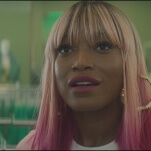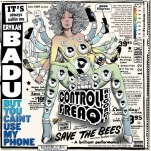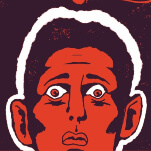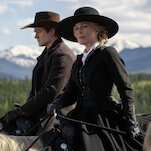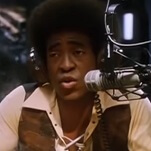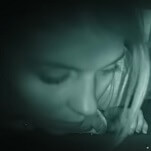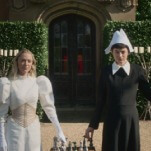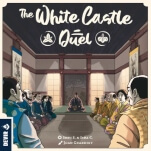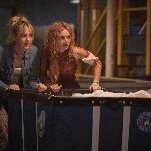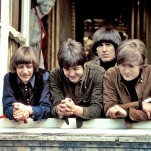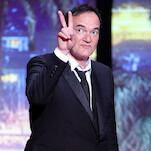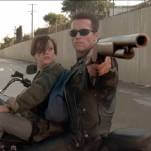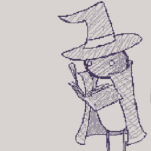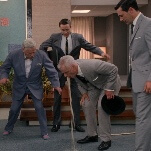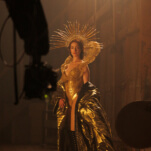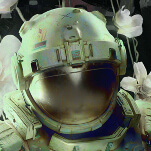Looking like a cross between Debbie Harry and a Nagel print, Charlize Theron struts her way through the Cold War howler Atomic Blonde dressed to the proverbial nines, in white pleather raincoats, tailored herringbone wool, and a deadly pair of red stiletto heels, often caressing a cigarette between her fingers. She also gets the shit kicked out of her; it seems no female action hero has taken as many punches to the mouth and eye socket or crawled out of a fight looking worse than Theron’s Lorraine Broughton. She’s a British spy sent to West Berlin in 1989, just days before the collapse of the Berlin Wall, though the actual plot of the movie is almost indecipherable: some junk about a McGuffin, a Stasi defector nicknamed “Spyglass” (Eddie Marsan), and a double agent. But it’s not like that matters. Atomic Blonde is a meaningless fetish piece of aesthetic extremes—grotesque injuries, mirrored neon décors that are like something out of a Nicolas Winding Refn movie, and enough references for a small encyclopedia—and it’s the handiwork of David Leitch, who made the deliciously absurd John Wick with Chad Stahelski. Based on the evidence of this film and Stahelski’s even stranger John Wick: Chapter 2, which hit theaters earlier this year, one might conclude that Stahelski brought the outlandishness to their jointly directed debut feature and Leitch brought the cool.
The cloak-and-dagger intrigue (which, again, borders on the impossible-to-follow) kicks off with a British agent being offed by a KGB goon to New Order’s “Blue Monday,” his corpse dumped into the icy waters of the Spree—which cuts to Lorraine dunking her bruised body into a claw-foot tub filled with ice, then palming a few of the ice cubes into a glass of Stoli. It’s that kind of movie. In a debriefing room at MI-6, she narrates the events of the preceding week to a British handler (Toby Jones) and a guest from the CIA (John Goodman): She is sent to West Berlin to recover a list of Western agents called, er, “the List”; makes contact with the punk-rock local station chief, Percival (James McAvoy), who has a side business selling Jordache jeans to East Berliners; stabs thugs at a screening of Andrei Tarkovsky’s Stalker; and has a fling with a rookie French intelligence agent, Delphine (Sofia Boutella). (Their gratuitous sex scene sets up one of Atomic Blonde’s funnier gag cuts.) Lorraine is a fantasy object—a statuesque Barbie-blond who fucks beautiful women when she isn’t fucking up ugly, cauliflower-eared Soviet henchmen—and Theron owns it. She purrs every line and relishes every opportunity to crack her neck while reclining into a leather chair.
Like John Wick before it, Atomic Blonde is set in a vacuum, a wacky pastiche of fashions, needle drops (“Voices Carry,” “Fight The Power,” “Behind The Wheel,” etc., etc.), out-of-context arthouse shout-outs (including a cameo from onetime Rainer Werner Fassbinder regular Barbara Sukowa), and retro cheese, topped off by a cut to a vintage clip of MTV’s Kurt Loder segueing from coverage of the fall of the Berlin Wall to a special report on sampling. (“Is it art or is it just plagiarism?”) All of the subtitles for the German dialogue are printed to look period-appropriate, to cite an example of Leitch’s obsessiveness. If it weren’t so divorced from reality—or if the viewer were asked to give a crap about any of the characters—the violence might seem horrifying. But whether it’s an opponent who refuses to stop fighting after getting stabbed in the face (there’s a lot of stabbing in Atomic Blonde) or a policeman with a hose around his neck being used as a counterweight in one of Lorraine’s escapes, Leitch plays it for black comedy. This is especially true of the climactic set piece, a deranged, mind-bogglingly long Children Of Men-style super-take in which our heroine fights a small group of KGB agents down the staircases, into the living rooms, and through the walls of an East Berlin apartment building, before making off in a crowd-plowing car chase and shoot-out—all directed with the cuts hidden by digital trickery.
This can be pretty fun, but also tiring in stretches; Leitch’s fetishistic interest in clothes, scar tissue, furniture, and different shades of mood lighting and lens flare gives some of the action-less portions of Atomic Blonde a glazed-over, narcotic pace. (The flashback framing device has almost no value, apart from surface texture.) Its brand of purely cosmetic bad-assery is never exactly boring, but it’s also intentionally uninvolving, even on a visceral level—a perverse accomplishment for a movie that features multiple characters taking frying pans to the face and a protagonist who limps her way out of half of the scenes. One might point out that of all the recent attempts to revive the Cold War, this is the only one to really emphasize its abstractness and arbitrariness. But that would be reading too much into it.




